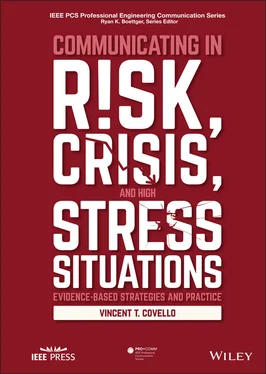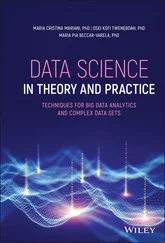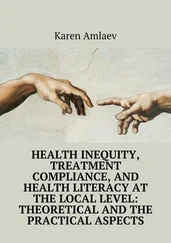I have organized this book to introduce theory and best practices in high concern communication, focusing specially on meeting the communication needs of those who work as engineers, technical professionals, leaders, or managers in fields that may encounter health, safety, occupational, and environmental responsibilities and challenges. Communications related to health, safety, occupational, and environmental issues are often stressful. They often raise complex technical, economic, social, political, policy, and ethical questions and then place the resulting demands on organizations.
I also wrote this book for technical professionals, leaders, and managers at all levels who desire to communicate more effectively in high concern situations within their organizations. For example, organizational change often raises concerns and emotionally charged issues from employees, including such questions as: What is the proposed organizational change and why is the change needed? Will I lose my job because of the change? How will the change affect me and my relationship to others? How technical professionals, managers, and supervisors respond to these and related questions is critical to the successful initiation and sustainability of change.
During high concern situations, ineffective communication can cause inefficiencies; disruption; low morale; and wasted time, money, and other resources. Ineffective communication results in messages being garbled by the noise, unintended adverse consequences, rejected messages, and unnecessary fear and confusion. When deployed effectively by leaders and managers at all levels, risk, high concern, and crisis communication skills serve as invaluable tools for engendering trust, protecting organizational value, and helping people make informed decisions.
Leaders, managers, supervisors, and technical professionals can benefit from effective risk, high concern, and crisis communication skills by ensuring their customers, potential customers, and the public have the information they need to evaluate the company’s products and operations. Effective communication often determines why some ideas and products are accepted over others, and why some individuals are accepted as leaders over others.
By keeping internal and external stakeholders informed about potential risks, corporations can reduce adverse outcomes and protect themselves from reputational damage. Internal stakeholders are particularly important because of their high credibility, especially when their views about a risk or threat differ from those of management. Similarly, nonprofit and governmental organizations can benefit from effective risk communication by educating and informing their constituents about threats and issues. With the ever‐widening array of information sources, the negative effects of misinformation are more likely and damaging. People may not be aware of critical information or may take actions based on misinformation.
Engineers, technical professionals, leaders, and managers, as well as students aspiring to these positions, can read this book, gaining a comprehensive overview of the most important aspects of the field. I wrote each chapter to be self‐contained and have provided additional resources for those who want to further probe particular topics. The intent is to make it easier for readers to home in on issues, such as stakeholder engagement, communicating numbers, decision‐making tools, warning systems, working with the media, theory, message development, or evaluation.
1.4 The Need for This Book – Now
Critical changes have occurred in the field and in the environment in which high concern communication occurs, changes further magnified and intensified by the coronavirus disease (COVID‐19) pandemic of 2020–2021 as described in the last section of this chapter. This book draws on new, and established, valid, and reliable research and applies it to relevant, complex, and difficult communications environments, including lessons learned in the extraordinary global public health crisis of the pandemic.
1.4.1 New Literature, New Research
The scientific literature on risk, high concern, and crisis communication has expanded considerably in the past three decades. From modest beginnings, there are now more than 8,000 articles published in journals and more than 2,000 books focused on risk issues. The research spreads across fields, drawing on the work of behavioral scientists, social scientists, engineers, economists, statisticians, medical scientists, toxicologists, epidemiologists, industrial hygienists, lawyers, media studies, neuroscientists, and a host of other disciplines. The field has benefited from these new understandings and insights.
The material needs to be selected, synthesized, and interpreted for practitioners, integrating new findings into concrete recommendations for application.
I wrote this book to give you that synthesis.
1.4.2 Changes in the Communications Landscape
Technological, economic, and social changes have upended many of the traditional ways that risk‐related information is communicated. Changes in communication technologies have radically transformed the way risk information is shared and transferred and how it is used.
Changes are occurring at both the societal and personal level that affect risk communication. Three of the biggest impacts of these changes are:
1 experts and authorities are less trusted;
2 whom to trust is now a central topic in virtually all risk, high concern, and crisis communications; and
3 the way the people seek information about risk, high concern, and crisis issues has shifted from traditional broadcast and print media to online sources and social networks.
Because of changes in the communications landscape, information about risks, high concern issues, and potential or ongoing crises is now readily available 24/7. The streams of information have increased exponentially. Websites of many news organizations update their information every few minutes.
On a personal level, powerful communication changes have resulted from the extensive use of social media and mobile device technologies. People exchange emails, send text and voice messages, make video calls, and share images, videos, diagrams, charts, and emoticons to express thoughts and meaning to what’s going on in their world and lives. Messages posted on a vast array of social media platforms communicate instantaneously to multiple recipients or mass audiences. Mobile communications allow people to connect from almost any location. People schedule and conduct virtual meetings with anyone in the world who can connect with them through the Internet or cellular network.
The wide use of social media and virtual interactions are making communications less nuanced as there are fewer face‐to‐face interactions. As a result of these impersonal interactions, information communicated with nonverbal cues makes it difficult to interpret the sender’s intended message. These changes are also influencing writing. For example, people are less likely to spell carefully and write complete sentences because of their increased use of text messaging and social media platforms. Their mode of communication more typically relies on short sentences or fragments, simple tenses, and a limited vocabulary, using phonetic spelling and little or no punctuation. As a result, texting and social media platforms encouraging brief messages are replacing traditional conventions in writing that enabled fuller explanation.
Changes in communications and communication technologies increase the volume of messaging about all topics. Email and texting are currently two of the most popular forms of online communication, even after discounting the large volume of spam messages sent. Beyond even normal increases based on ease of email/text use, many people are addicted to checking and sending email or texts. Billions of business and consumer emails are sent each day. Information overload increases, which also hampers communication. Dependence on continual online interaction also makes communications by individuals and organizations more vulnerable to problems such as mass power outages, disruptions, scams, identity theft, and cyberattacks.
Читать дальше












